Comptroller Kevin Lembo Archive > News
COMPTROLLER LEMBO PROJECTS $43.4-MILLION SURPLUS FOR FISCAL YEAR 2014Comptroller Kevin Lembo today announced that the state is currently on track to end Fiscal Year 2014 with a $43.4-million surplus, as reported last month.
In a letter to Gov. Dannel P. Malloy, Lembo reported that while revenue is running below original budget targets, spending controls have successfully kept the budget balanced.
Lembo said General Fund revenue for Fiscal Year 2014 is expected to be $40.6 million below the original budget plan. The largest shortfall is in the income tax, which is estimated to underperform the budget plan by $176 million. This is a variance from the original budget of about 2 percent. Both the sales tax and corporation tax are exceeding initial budget estimates by $65.6 million and $42.5 million respectively, Lembo said.
Overall General Fund expenditures for Fiscal Year 2014 are projected to be $79.6 million below the budget plan.
The General Fund surplus will be deposited to the Budget Reserve Fund, as Lembo has advocated, to help guard against future financial challenges.
"I have emphasized that the state faces new financial challenges in the
outlying years," Lembo said. "It is critically important that we directly
deposit any surplus into the Budget Reserve Fund. I have advocated for a reserve
level of 15 percent of spending. Sufficient dollars in reserve will guard
against future tax increases and service reductions during inevitable future
recessionary cycles."
The reserve balance -- often referred to as the "Rainy Day Fund" -- at the end of Fiscal Year 2013 was $270.7 million, which represents approximately 1.6 percent of net appropriations.
"It's important to note that, despite our struggle to find the economic lift that we should expect, the state's economy is improving overall ," Lembo said, pointing to a third consecutive month of employment growth.
"Gradually diminishing state unemployment, which fell to 6.9 percent in April, and rising home sales, are promising signs for Connecticut's economic outlook," Lembo said. "Three months of job growth must be continued - and followed by improved wages and worker productivity."
Lembo highlighted data and other information from federal and state
Departments of Labor and other sources that show:

- Year-to-date gains in the employment-driven withholding portion of the state income tax remained positive through April, growing 2.7 percent from a year ago.
- The monthly growth in year-to-date withholdings has averaged 1.2 percent so far in Fiscal Year 2014. As can be seen from the graph below, monthly receipts accelerated during the second half of the year.
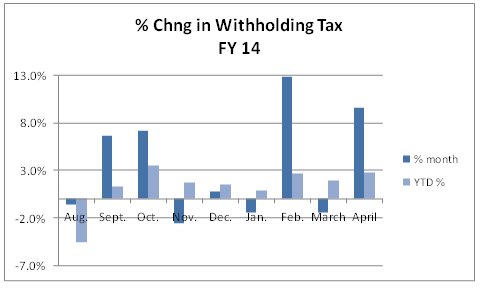
- Connecticut gained 2,200 payroll jobs in April. This is the third consecutive month of employment growth in the state. According to the Department of Labor, Connecticut has regained 66,300 payroll positions, or 55.7 percent of the 119,100 positions lost to the March 2008 - February 2010 employment recession. Nationally, all of the jobs lost to the recession had been recovered by March 2014.
- The table below shows the distribution of employment gains and losses by super sector over the latest 12-month period.
| Job Gains Latest 12 Months | Job Losses Latest 12 Months | ||
|---|---|---|---|
| Sector | Sector | ||
| Education &health | 5,600 | Government | -3,900 |
| Leisure and Hospitality | 4,400 | Manufacturing | -2,600 |
| Construction | 3,000 | Prof. & Business Service | -800 |
| Transp. & Utilities | 2,400 | Financial Activities -500 | |
| Other Services | -500 | ||
| Information | -200 |
- Connecticut's unemployment rate was 6.9 percent in April; the national unemployment rate was 6.3 percent that month.
- The charts below are a time series view of Connecticut employment and the
unemployment rate.
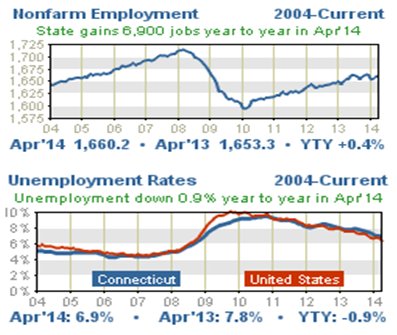
![]()
- The Department of Labor calculates that average private sector weekly pay was $938.21 in April, down $5.28, or -0.6 percent over from the same period a year ago.
- The year-to-year change in the Consumer Price Index for All Urban Consumers (CPI-U, U.S. City Average, not seasonally adjusted) in April 2014 was 2 percent.
- Worker productivity has been on a downward trend as businesses have invested less in the technology that has resulted in productivity increases. Typically, lower productivity creates inflationary pressures and higher interest rates over time.
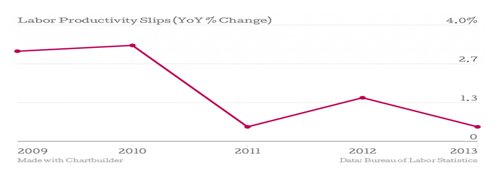
- Based on data released by the Bureau of Economic Analysis on March 25, Personal income in Connecticut grew at a rate of 2.1 percent between 2012 and 2013 ranking the state 37th nationally in personal income growth. Net earnings increased 1.4 percent while dividends, interest and rent increased 3.7 percent. Personal income results for the 1st quarter of 2014 will be released on June 24.
- The chart below shows the annual trend in Connecticut personal income. Because the state spending cap is based on the growth in personal income (or the rate of inflation if higher), the current trend places downward pressure on budgeted state spending. The cap does not apply to debt financed spending.
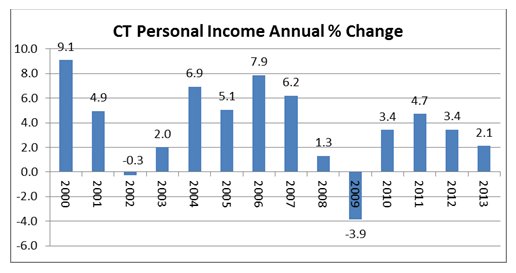

- A strong housing market has lifted Connecticut's real estate conveyance tax receipts. Through April, total receipts are running more than three-quarters above last year's level.
- Single-family home sales in Connecticut rose 3.2 percent in March according to a May 8 report from The Warren Group. This is a slight acceleration over February sales and is the eleventh consecutive month of home sale gains in the state. The 3.2-percent increase is below the 6-percent growth rate posted for the full 2013 calendar year, but weather played a role in slowing winter sales activity, and the spring and summer normally bring higher sales volume.
- The median price of single-family homes in the state fell by 8.2 percent in March, selling at $225,000 compared with $245,000 in the same month last year. Prices of single-family homes were also down by 2.1 percent in the 1st quarter of 2014 with a median selling price of $230,000, compared with $234,900 last year. The price decline in March was the first since June 2012, which suggests that it is an aberration in the data.
- Condominium sales in March were up 8.1 percent from the same month last year. This is consistent with the strong double-digit growth in 2013. The median price for a condo fell 3.5 percent in March to $154,500 compared with $160,000 in March 2013.
- According to the National Association of Realtors, total U.S. existing home sales in April were 6.8 percent below April of 2013. The median price of a home rose 5.2 percent to $201,700 from April of last year. Regionally, existing home sales in the Northeast fell 6.3 percent from last April and prices were relatively unchanged at $244,000.
![]()
- The capital gains-driven estimated payment portion of the income tax grew by almost 18 percent last fiscal year. This large increase was partially attributable to a capital gains tax change that went into effect at the end of 2012 and resulted in a roll-forward of taxable gains to Fiscal Year 2013. Absent the tax change, these roll-forward gains would have been realized in future years.
- The budget plan anticipated a softening of estimated payments in Fiscal Year 2014 based on the roll-forward activity. However, the loss was far greater than expected, as we reported last month, resulting in a $389.1 million downward revision in the income tax projection last month.
- During periods of economic growth, estimated and final payments represent an increasing percentage of total income tax receipts. These receipts are correlated to equity market activity and are especially volatile. As can be seen from the graph below, the percentage of the total income tax expected to be realized in Fiscal Year 2014 from estimated and final payments approximates the Fiscal Year 2012 results. This was unexpected since growth over Fiscal Year 2012 would be typical of a recovery period.
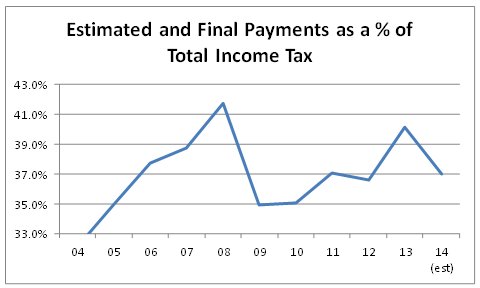
- It is difficult at this point in time to accurately determine the cause of the deviation in final income tax payments from the historical trend. Certainly the forward shift in capital gains discussed above played a role. It is also significant that profit taking has been on a downward trend since the height of the financial crisis as trading volume has receded even as the market has risen.
DOW
- At this writing the Dow Jones Industrial Average has posted a 12-month gain
of 8.16 percent; however, on a calendar year-to-date basis the market has seen
little growth.
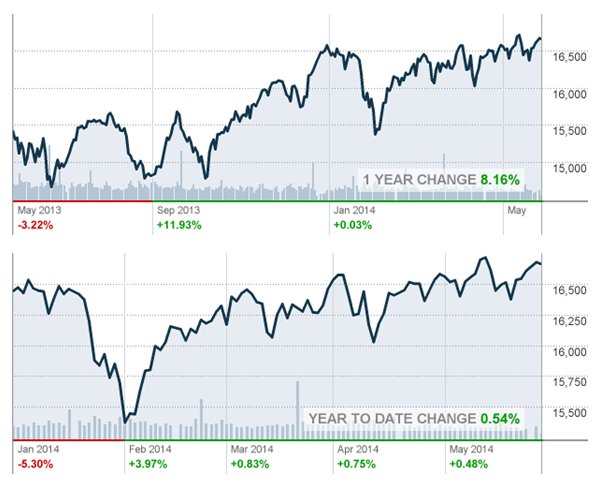
Consumers
- Through April the sales tax receipts were advancing at a rate of over 5.5 percent on a fiscal year-to-date basis. This is the growth rate anticipated within the current revenue forecast.
- April advance retail sales were up 4 percent from the same month last year. In calendar year 2013, sales were 4.2 percent higher than in 2012.
- According to the Federal Reserve, in March consumer credit expanded at its strongest level since the start of 2014. Total credit expanded 6.7 percent in March. Credit cards advanced 1.6 percent, while non-revolving credit (for things like automobiles and student loans) was up 8.7 percent.
Business and Economic Growth
- Based on the May 29 release by the Bureau of Economic Analysis, real GDP decreased at a rate of 1 percent in the 1st quarter of 2014. In the 4th quarter of 2013 real GDP advanced 2.6 percent.
- The deceleration in real GDP growth in the first quarter primarily reflected downturns in exports and in nonresidential fixed investment, a larger decrease in private inventory investment, a deceleration in personal consumption expenditures, and a downturn in state and local government spending that were partly offset by an upturn in federal government spending and a downturn in imports.
- In the 1st quarter of 2014, corporate profits posted a decline of 3 percent from one year. Profits grew by better than 7 percent in both 2011 and 2012.
- The Department of Labor's General Drift Indicators are composite measures of the four-quarter change in three coincident (Connecticut Manufacturing Production Index, nonfarm employment, and real personal income) and four leading (housing permits, manufacturing average weekly hours, Hartford help-wanted advertising, and initial unemployment claims) economic variables, and are indexed so 1986 = 100.

